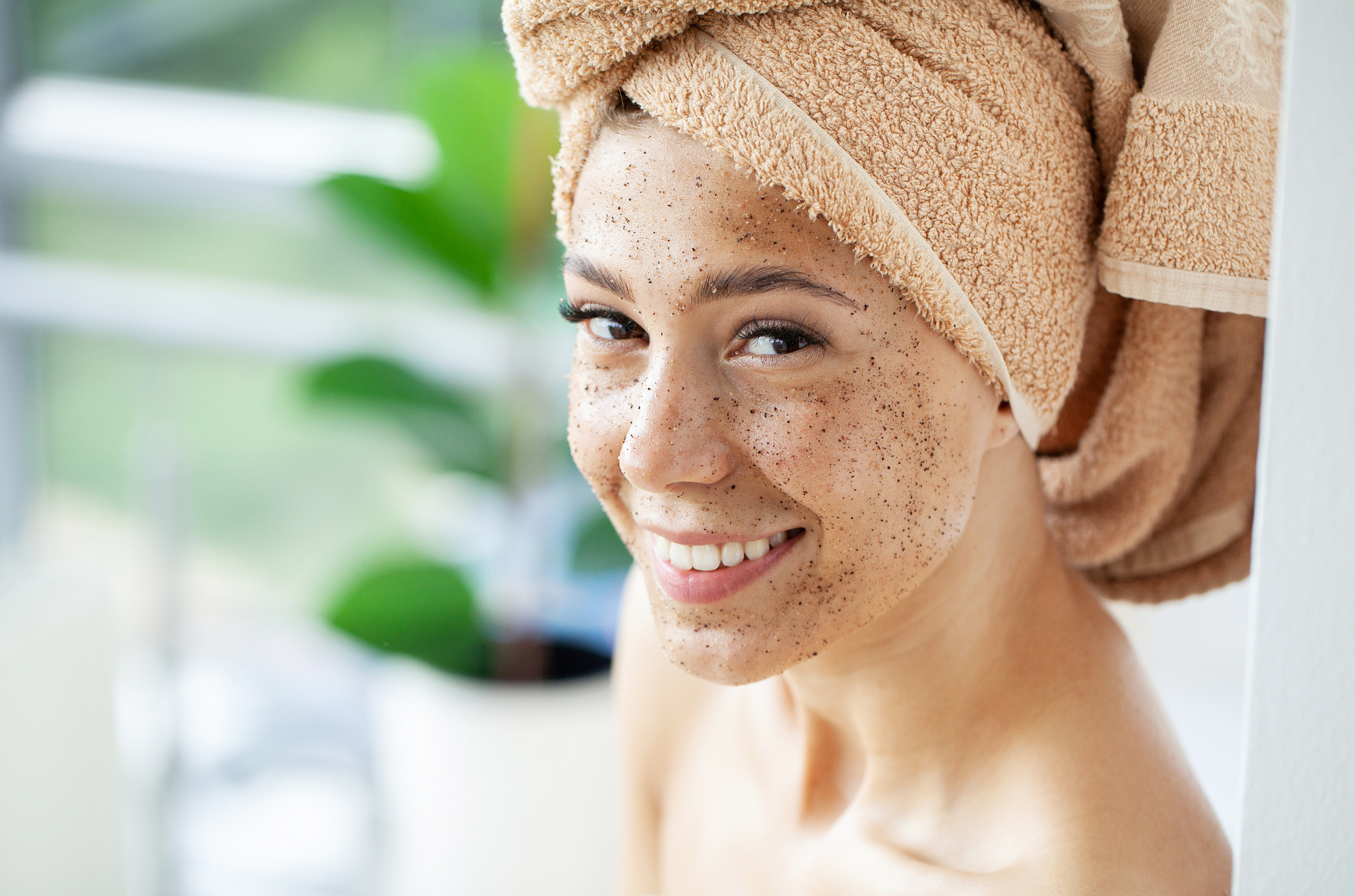
Your skin is on a constant journey of renewal, naturally shedding dead skin cells every 30 days to reveal the fresh, luminous skin beneath. This natural process is crucial for maintaining a healthy, glowing complexion. However, sometimes our skin needs a little extra help in this cycle, especially when it starts showing signs of flaky skin, clogged pores, or dull appearance. This is where the magic of exfoliation comes into play.
Exfoliation, the process of removing dead skin cells from the skin's surface, can be a game-changer in your skincare routine, offering a pathway to more vibrant and smoother skin. But, if done incorrectly, exfoliation can lead to more harm than good, stripping the skin of its natural oils and causing irritation.
So, what's the best way to exfoliate, and when should you incorporate it into your skincare routine?
What is Exfoliating and Why Should You Do It?

Exfoliating is the process of removing old, dead skin cells from the surface of your skin to help accelerate the natural skin cell turnover cycle. Normally, your body sheds these cells every month or two, a process that may slow down as you age.
But why exfoliate in the first place?
- Boosts Skin Glow: By removing the layer of dead cells and revealing the renewed layer of skin underneath, exfoliation can transform your skin, making it look more vibrant and smooth. This renewal process is essential for maintaining a fresh appearance.
- Improves Skin Tone: Regular exfoliation not only helps in achieving a more even skin texture but also plays a significant role in fading dark spots over time. This benefit is attributed to the reduction of melanin, the pigment responsible for skin discoloration, through careful and consistent exfoliating practices.
- Prevents Breakouts: By clearing the buildup of dead skin cells that can clog pores, exfoliation is a critical step in minimizing and preventing acne breakouts. This process ensures your pores are free from the debris that can lead to inflammation and pimples.
Incorporating exfoliation into your skincare routine is more than just an extra step; it's a fundamental practice that can lead to healthier, clearer, and more glowing skin.
What Are the Different Types of Exfoliating Products
The world of exfoliation has two key players: physical and chemical exfoliation. Each brings its own benefits to the skincare game, catering to different needs and preferences for a smoother, brighter complexion.
- Physical Exfoliation: Involves manual effort using tools such as scrubs, pumice stones, and dry brushes to physically remove dead skin cells from the surface. This method requires you to scrub or brush your skin to achieve exfoliation.
- Chemical Exfoliation: Utilizes products containing alpha hydroxy acids (AHAs) like glycolic acid, beta hydroxy acids (BHAs) like salicylic acid, retinols, and retinoids to remove dead skin cells. These chemical exfoliators work by dissolving the bonds between skin cells, allowing for a deeper exfoliation beneath the skin's surface.
Chemical exfoliants are generally more gentle and effective compared to physical exfoliants. However, they can cause irritation if not used properly. Additionally, it's recommended to use only one type of exfoliant at a time to avoid over-exfoliating or stripping the skin of its natural oils.
Tailoring Exfoliation to Your Skin Type

Understanding the methods of exfoliation is just the first step. To truly target your exfoliation routine, it needs to align with your skin type.
Dry Skin Types or Sensitive Skin Types:
- Frequency: Start with a gentle approach, exfoliating once a week. If your skin responds well without signs of irritation, you can up the frequency to twice a week.
- Type: Steer clear of physical scrubs to avoid damaging your skin's moisture barrier. Instead, opt for gentle chemical exfoliants which are less likely to provoke sensitive skin.
- Aftercare: Post-exfoliation, it's crucial to replenish your skin's moisture. Look for moisturizers packed with ceramides, hyaluronic acid, and glycerin to keep your skin hydrated and protected.
Combination Skin Types or Oily Skin Types:
- Frequency: Oily skin can typically handle chemical exfoliation two to three times a week, thanks to its resilience and higher tolerance for active ingredients.
- Type: Salicylic acid is a star for oily skin, good at dissolving excess oil and preventing pore blockages. That being said, moderation is key since too much exfoliation can strip the skin.
- Note: While oily skin may seem more tolerant than other skin types, maintaining the moisture barrier is still essential to prevent overproduction of oil.
Acne-Prone Skin:
- Frequency: Begin with once-a-week sessions to gauge your skin's tolerance. If positive, gradually increase to two or three times weekly, allowing rest days in between.
- Type: The dynamic duo of salicylic and glycolic acids is recommended for their ability to battle acne, thanks to their anti-inflammatory benefits and ability to cleanse deeply.
- Caution: Be mindful of over-exfoliating, especially if you're also using prescription acne treatments since this can affect your skin barrier and potentially worsen acne issues.
Eczema or Rosacea-Prone Skin:
- Consultation: These skin conditions need a cautious approach. Consult with a board-certified dermatologist before incorporating exfoliation into your routine.
- Frequency and Type: Depending on professional advice, mild chemical exfoliation may be suitable, but physical methods should generally be avoided to prevent aggravating the skin.
- General Advice: The goal is to maintain skin health without triggering irritation. Professional guidance is crucial for safely incorporating exfoliation into your care regimen for these sensitive skin types.
Each skin type has its own needs and tolerance levels for exfoliation. By paying attention to how your skin responds and adjusting your routine accordingly, you can enjoy the many benefits of proper exfoliation without the drawbacks. Remember, when in doubt, consult with a skincare professional to tailor the approach to your unique skin.
Buffing Up the Basics: Body Exfoliation Tips
Exfoliating your body deserves just as much attention as your face, serving as a critical step toward achieving that all-over glow and smoothness. When diving into body exfoliation, starting with the right tools and products is key. Opting for a physical exfoliator, like a specially formulated body scrub, can make all the difference. These scrubs are designed to effectively slough off dead skin cells without being too harsh on the larger expanses of your body.
While there are many exfoliation methods and tools for the body, finding one that’s effective and gentle is crucial. For those on the hunt for the perfect tool, Frownie's Dry Brush is designed with boar’s hair bristles to invigorate the skin without causing irritation when used properly. Before your next shower, consider the benefits of dry brushing, an age-old technique celebrated for its effectiveness in boosting circulation, aiding lymphatic drainage, and removing dead skin cells. Using our stiff-bristled brush, gently brush your skin in a circular motion. This method not only exfoliates but also helps to minimize ingrown hairs by keeping the follicles clear.
Don't forget to give extra attention to those tougher areas—elbows, knees, and heels—that can accumulate dead skin and benefit from a bit more exfoliation. After you've exfoliated, hydration is your next step. Applying a generous amount of moisturizer or body butter while your skin is still damp can lock in moisture, leaving your skin feeling silky and nourished.

Smooth Moves: Exfoliating Secrets from Frownies
For most, exfoliating the body 2-3 times a week strikes the right balance, promoting cell turnover without overdoing it. However, it's important to listen to your skin. If you notice any redness or irritation, it might be time to dial back the frequency.
Exfoliation plays a crucial role in any comprehensive skincare routine, offering a simple yet effective way to maintain glowing, healthy skin. By removing dead skin cells and promoting cell turnover, exfoliation helps to keep your skin looking its best, feeling smooth, and fully absorbing the benefits of your skincare products.
At Frownies, we understand the importance of natural, effective skincare solutions. Our range of all-natural skincare products, including our body brush, is crafted to support and enhance your skin's health. By incorporating Frownies' products into your routine, you're not just upping your exfoliating routine; you're taking a step towards a healthier, smoother you!